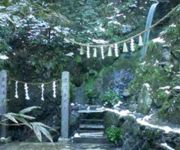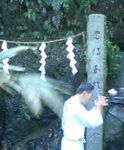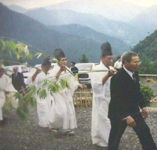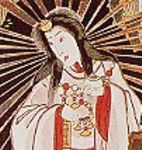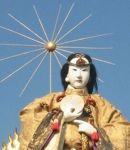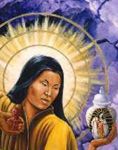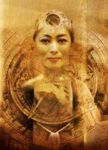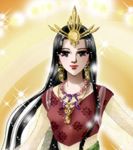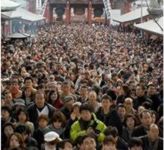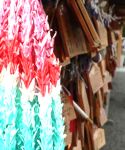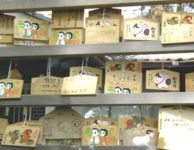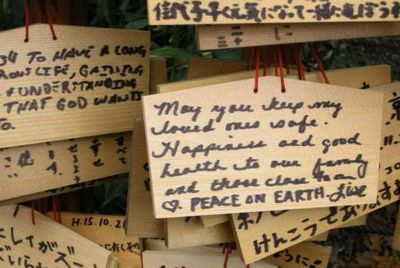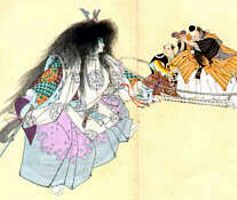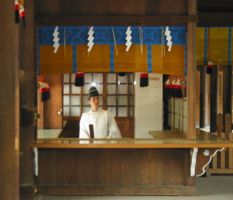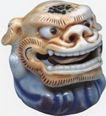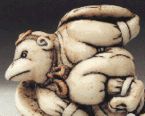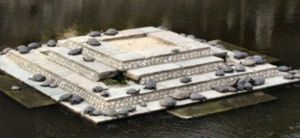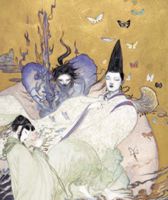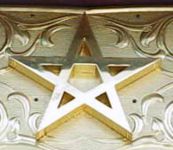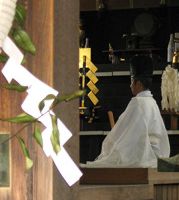S H I N T O
|
This is the only 'religion' on this planet that was founded by a nation. Sure, tribal gods are abundant and ethnic beliefs are innumerable -- the Javanese, for instance, always have their entire cosmology intact; but there is no Republic of Java or 100% sovereign Kingdom of Java registered at the United Nations. Because of that, Shinto can't get exported, and never seeks conversion because such a thing is impossible; you are Shintoist if you are Japanese, and Japanese if Shintoist, since a thousand years before the first year on the Christian calendar. And as you might have known, it is nearly impossible to put this belief under scrutiny -- even if you hire Sherlock Holmes, the thing -- the real thing -- of Shintoism always manages to dodge surveillance. The Japanese have been living this thing forever, and never even bothered to give it a name; naturally they never consider it as something to sniff around of, either. So everything about Shintoism is just the non-Japanese fuss. In and around Japan, you'd find manifestations of both Shintoist and Zennist beliefs not just side by side but often at once within a single thing. For all practical purposes it is useless to whack the thing open for the 'Zen elements' and 'Shinto ingredients' therein (click back to the previous page for pictures of the stuff I'm rapping about). These things are Japan. End of discussion. I'll try anyway to get near to what Shinto really is, via the same stuff that are also Zen Buddhist, and this headlong approach yields such stuff as follows:
Name: Nothing, until Buddhism was imported between the year 500 and 600 and all of a sudden this thing was called 'Shinto' by the Buddhists. Meaning of that name: 'Shin' is written the same way in Chinese kanji as the word 'kami' of the Japanese lexicon (see the word in the sub-header pic above). 'Kami', of course, means 'spirit'; here gods are included. 'To' means 'the way', the same as 'do' (as in 'bushido'); they are even pronounced the same way. Thus 'Shinto' means 'the way of the spirit(s)', or, if the spirits referred to are those of awesome power, 'the way of the gods'. So you know now, it still is not a name, because every system of belief is the way of the gods -- differing only in which gods. Birth: 660 years before Christ, if you ask a Japanese. If you address the same FAQ to an outsider, you'd get the answer that it was rather systematically revealed for the first time in the ancient book of history of Japan (or more precisely history of the Japanese, as a people), titled 'Kojiki', which was released in either the year 680 or 712. Nobody claimed copyright proprietorship of this book, but it was not written by Jehovah on top of Mt. Sinai. It was written as a counter-measure against the flood of Buddhist scrolls. Click here for photographs of the birthplace of Shinto.... Click here for Shinto 'Genesis' & the first of their gods. 'Bible': None. Everybody remembered the whole family tree of the Emperor's, and that was all that they needed. Core: animism, dynamism, everything around those two; i.e. beliefs around the good ol' Nature, which is taken as a great warehouse of spirits. Shinto is about these unseen and untouchable substances.
Peak of the above: Mount Fuji. Hiking around the area is not sport; it is a pilgrimage. Basis: The Goddess of the Sun, a.k.a Amaterasu o-mi-kami. She's really THE basis of everything. Without her, there would never have been Japan. The Days of the Goddess is July 17 and December 21.
Practical basis: The 'first Emperor of Japan', Jimmu, had the DNA of the Goddess of the Sun. So every one of the 124 Emperors and Empresses after him did, too, although the 124th Emperor (Hirohito) sort of disclaimed the lineage after the atomic bombs razored Hiroshima and Nagasaki in 1945 (click here for all the emperors, empresses, and rulers of Japan since 660 BCE until today), after which the Japanese national anthem was still saying "May the Emperor Reign For 8,000 Generations" anyway. The Japanese imported its almanac from China (see previous page), but they tailored it so that Year One started at the ascension of Jimmu, i.e. 660 years before Jesus was said to have been born. Note for the above: That was the 'national Shinto', which had never been before Emperor Meiji took active governing over from the Tokugawa shogunate (1869; click here for everything about that).
Hence, so to speak: The thing most characteristic of Shintoism, which differs it by lightyears from any branch of Buddhism, is 1). ancestral worship, that centers on the Imperial Family Tree. And that's why the Japanese people, especially the samurai class, upheld their own kind of filial piety that was entirely different from what China's Confucianism says about it (click here if you have no idea what I'm talking about). A marked difference also can get nailed down at 2). Shinto's absolute refusal to have anything to do with death. Not just differentiating it from Buddhism, this particular streak, but from probably every system of belief on earth -- because religions were mostly invented to help humans to cope with the eventuality of death. So you'll never see Shinto priests (btw the Japanese word to call them by is 'kennushi') conducting a funeral rite. With the exception of Abe Seimei's side-jobs of Lazarusian nature, all things about death has always been Buddhist priests' territory that excludes Shintoism, until after the thing is done with and now Shinto can deal with the spirit of the deceased. The steadfast 'no' on this matter is a logical consequence of Shinto's other trait that sets it up as something different from Buddhism: 3). some sort of obsessive-compulsive habit around 'purity' and 'cleanliness'. Shintoists are always busy with 'cleansing' rituals, literally, that serve the spiritual janitorial jobs, too. Shinto really abhorred both worldly dirt and mental junk; that's why Japan is, generally, very hygienic and sterile, which is one of only a few good things the Tokugawa shogunate left us with, since the regime mixed this Shintoist attitude with Buddhist reasons, so that people changed their clothes and went to public baths and vigorously freed their houses from rubbish regularly for spiritual benefits rather than physical health. This can be glimpsed-at on the diet, too. The Japanese food, which 'doesn't taste at all' according to the standard of the rest of Asia (China, Indonesia, Malaysia, Brunei, etc. have their traditional food heavily spiced) reflects the same preoccupation with 'purity'. The generally unseasoned food of Japan is let to look and taste as nature intends it to.
Basix: What's so darn cool about Shinto is more than its obvious lack of 'Bible' and so on -- but its fundamental principle itself: it has nothing like the frowning Jehovah. It's not a 'religion of fear' like others; it is, on the contrary, a 'religion of gratitude' and of love, for real, which doesn't even mean love being pushed on you via crucifixion. No Shinto god is terrible, even the Goddess of the Sun's brother -- the worst in the family -- was more like mischievous than disastrous. No Zeus sending down thunderstorms, no Sodom and no Gomorrah. There are gods who were made so because they were scary -- but being deified because of people's fear and being feared because you're divine are two different things. The fearsome Taira Masakado wasn't born as a god, right? Shintoism is about expressing gratitude and love towards everything that are awesome (Mount Fuji is a splendid example), things that are useful (farming equipments, wells, etc.), and -- this one trait is without parallel -- things that make you happy (flowers, rivers, etc.). About being human, Shintoism digests things this way. Every one of us has a soul, right? This soul is called 'reikon' when it is still attached to physical presence, i.e. the soul that does the laundry, gets online and bears redundant Windows meltdown. When the soul leaves that largely wretched body, it becomes just itself, i.e. what is dubbed 'kami'. Everyone is a 'kami' when deceased, because the basis of existence is exactly that. A spirit freed from household chores and the humdrum of moneymaking is more powerful than before, since it doesn't even need airlines to go anywhere, though as a rule most of the liberated spirits just stick on to where their fleshly containers used to roam.
So they are in the position to grant wishes, extend protection, or entirely the opposite, in which case they become what is called 'yurei', AKA 'ghosts', constantly mad at someone and something, and the power they automatically have would then be used to wreak havoc among the living. Every summer, good spirits visit the home of their families, and this is why the Japanese hold the festival of fire ('Obon') as a welcoming gesture that is assumed to be delivered in a visual language ghosts understand best. 'Obon' is said to be something Buddhist, but actually it is synchretic. Non-humans also have spirits, as a matter of fact. So they, too, are in the same position in relation with their worldly masters or foes. To ward off evil from this and other directions, you have to please a number of animals, real or mythical or half of both -- raccoon-dogs ('tanuki'), foxes ('kitsune'), monkeys ('saru'), lion-dogs ('komainu'), lions ('shishi'), 'tengu', 'kappa', and so on. Shrines made for animals are all Shintoists. Click here for pictures and rap about the animals whose pix are at another page of this site.
Those were the more or less indigenous non-humans with the power upon your life. But, like I said before, Japan was incurably synchretic. So they shintosized the non-humans imported from China, the ones that Heian court shaman Abe Seimei (see the actor Nomura Mansai at another page) invoked in his final battle against Doson in the movie 'Onmyoji':
The turtle, phoenix, dragon, and white tiger are the protectors of the realm -- not per individual or per household, but the whole Japan or at least the whereabouts of the Imperial House and courtiers, from the theoretical four directions of the wind.
The four protectors of the Land of the Rising Sun have been constantly pushed onto the silverscreen and into comic books (click here for history and galleries of Japanese anime and manga). One of the masterpieces yielded by THE 'father of anime', Osamu Tezuka, is the manga series and anime movie about the Phoenix ('Suzaku'). Both the white tiger and turtle were in the movie Gamera. While the dragon was personified by the character named matter-of-factly 'Shiryu' in one of the anime series that sparked a cult until today, Saint Seiya, created by Kurumada Masami. So, the Shintoist Abe summoned all four of them to help him locking up the angry Sawara spirit that intended to commit the empire to oblivion (see the History of Japan for the complete real-life story). You must have remembered the duel if you did watch the movie. Anyway, Abe Seimei is the most famous Shinto priest ever because of that movie, so here he is again:
Abe's job was, in Japanese, as an 'onmyoji'. The job-description comprises of priestly stuff such as leading a mass-prayer, conducting rituals, giving blessings, putting up offerings, maintaining shrines, and exorcism or the opposite. An onmyoji is also a consultant in the widest range of interests; you can ask him to name the best date to marry, to build a house, to hire and sack employees, to name your kids, to choose either this or that girl to date, to keep or divorce your wife, and so on. In today's China, these make for the same job description as that of 'fengshui' expert. What sets an onmyoji apart from ordinary priesthood is astronomy & astrology. Onmyoji is an astronomer and almanac-deviser besides all those. This was, of course, not astronomy as in the 20th century, but the people who 'read the celestial signs' were the onmyoji, not any belief's priests as such. The term 'yin-yang master' applied to Onmyoji refers to the fact that those readings of bodies in the skies were based on the Chinese cosmology (most expressively in Taoism) that separated everything into the masculine or positive ('yang') and feminine or negative ('ying'). It's what the symbol below means, which, in Japanese, has also been a popular name to call kids by: Tomoe:
Onmyojiism -- Japanese shamanism -- isn't exclusively Shintoist. Buddhist priests can also do it, in a different way, and if they specialize in it, they, too, are called 'onmyoji'. How to tell the difference between temples (which are always Buddhist) and shrines (Shintoist)? Click on to the next page. |
||||||||||||||||||||||||||||||||||||||||||||||||||||||||||||||||||||||||||||||||||
| Samurai's Zen | Shinto Part 2 |
Site & Rap © 1996, 1997, 1998, 1999, 2000, 2001, 2002, 2003, 2004, 2005, 2006 Nina Wilhemina
All rights reserved. Every borrowed image at this site is put for non-profit educational purposes only.
HOME
 LINKS
LINKS
 CONTACT
CONTACT
 CREDITS
CREDITS
 COMMENTS
COMMENTS

